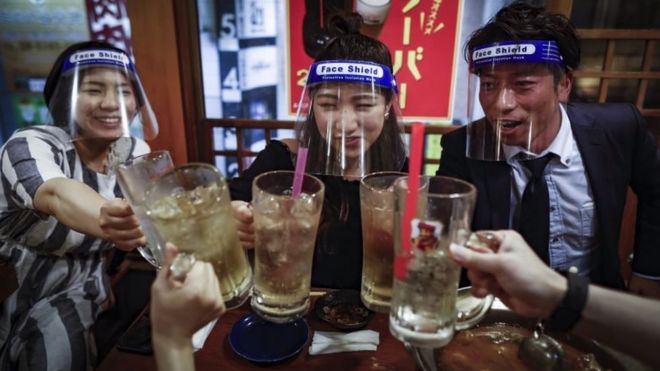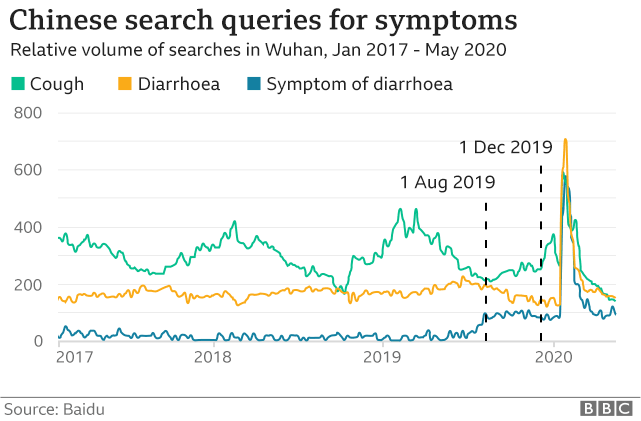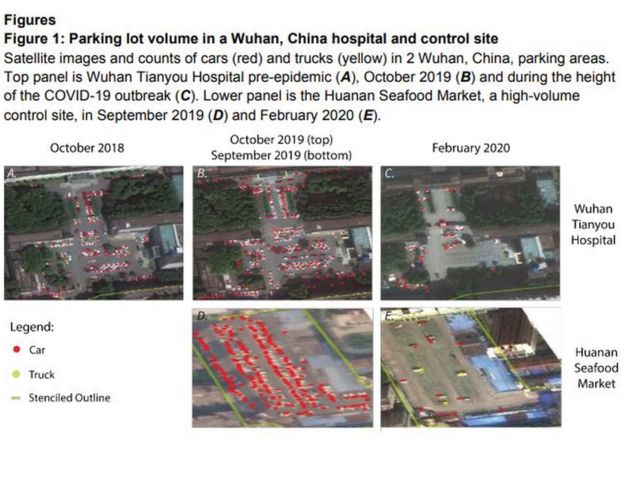Summer sun can kill virusSunlight can kill the coronavirus in just 30 minutes, according to a study that comes as the UK gears up for its hottest week of the yearVirologists found powerful ultraviolet (UV) light could destroy 90 per cent of Covid-19 that had been coughed or sneezed onto a surface in just half an hour.
Separate studies have claimed the sun can also almost completely wipe out parts of the virus lingering in the air in just six minutes.
The coronavirus that causes Covid-19 - called SARS-CoV-2 - is covered in a protective casing that degrades under the warmth of the body when it infects someone. When it is coughed or sneezed into the air or onto a surface, UV light will destroy its coating and leave the virus exposed to dry out and decay in the sun.
Some scientists also believe vitamin D, made in the body when exposed to sunlight, boosts the immune system and helps fight off viruses.
It comes as millions of Brits are expected to flock to beaches and parks on Thursday when temperatures soar above 86F (30C). Concerns have been raised that social distancing will become an afterthought and mass gatherings could cause a spike in transmission again.
But the researchers say being outdoors is safer than being cooped up inside, where Covid-19 can survive and stay infectious for days.
The study adds to fears Covid-19 may return in winter when lockdown restrictions have been eased, daylight hours are shorter and viral illnesses in general are more common. If that happens and there is another major outbreak, the NHS will once again be at risk of getting overwhelmed.
It comes as scientists suggested yesterday the multiple outbreaks in meat-packing factories in the UK could be proof that a second-wave is expected this winter, saying it was possible the 'cold environment makes people more susceptible to the virus'.
Strong British summer sunlight can kill the coronavirus in just 30 minutes, according to a study that comes on the hottest week of the year in Britain. Pictured: Crowds on the beach at Brighton Pier on Monday
By comparison, it would take roughly an hour and 17 minutes to destroy the virus in the capital in September and nearly three hours in March.
DO STUDIES SHOW SUN CAN KILL THE VIRUS? It has long been known that UV light has a sterilising effect because the radiation damages the genetic material of viruses and their ability to replicate.
Most viruses - such as SARS-CoV-2 - are covered with a thin membrane that is easily broken apart by UV rays.
A Columbia University study published in Scientific Reports two years ago showed the light can kill more than 95 per cent of pathogens like the coronavirus.
Germicidal UV light is used in hospitals in the US as well as ones run by the NHS in the UK to clean rooms and equipment.
One study by the US National Biodefense Analysis and Countermeasures Center, found coronavirus coughed into the air could be killed in six minutes by strong sun.
Another, by Harvard University, showed that influenza could survive on surfaces for nearly 24 hours in 43F (6C) dry weather, but died in under an hour in temperatures of 90F (32C).
A University of Oxford study in May also revealed that while the global coronavirus death rate was 0.2 per cent, in the colder northern hemisphere it was 0.3 per cent.
The researchers observed that in Italy, the warmer south was much less impacted than the north.
Despite the growing evidence, the World Health Organization warns that you can catch COVID-19, 'no matter how sunny or hot the weather is'.
Cases of the deadly virus have been recorded all over the globe, including in West Africa and the Middle-East.
Scientists agree that you are always at risk of catching the virus in the middle of an outbreak because it is indiscriminate and never sleeps.
Conventional germicidal UV light kills microbes but also penetrates the skin, raising the risk of various forms of skin cancer as well as cataracts.
But in winter, the virus could thrive for more than five hours in weak sunlight and has the potential to stay alive for days indoors.
For more northern regions in the UK, which tend to get less powerful sunlight, it would take slightly longer to destroy the virus.
The researchers estimate it would take around 34 minutes in the summer, an hour and 40 minutes in autumn, four hours in the spring and five-plus hours in the winter, The Telegraph reports.
Writing in the study, the researchers said: 'Forcing people to remain indoors may have increased or assured contagion of Covid-19 among same household dwellers and among patients and personnel inside the same hospital or geriatric facilities.
'In contrast, healthy people outdoors receiving sunlight could have been exposed to a lower viral dose with more chances for mounting an efficient immune response.
'The viral persistence estimated here for cities at northern latitudes where Covid-19 expanded rapidly during winter 2019-2020 and relatively higher viral inactivation in more southern latitudes receiving high solar radiation during the same period, suggests an environmental role for sunlight in the Covid-19 pandemic.'
The study follows a wealth of papers that have highlighted similar findings.
One study by the US National Biodefense Analysis and Countermeasures Center, found coronavirus coughed into the air could be killed in six minutes by strong sun.
Another, by Harvard University, showed that influenza could survive on surfaces for nearly 24 hours in 43F (6C) dry weather, but died in under an hour in temperatures of 90F (32C).
A University of Oxford study in May also revealed that while the global coronavirus death rate was 0.2 per cent, in the colder northern hemisphere it was 0.3 per cent.
The researchers observed that in Italy, the warmer south was much less impacted than the north.
Several studies have also suggested vitamin D can shield people from falling seriously unwell with COVID-19, with sunshine being one of the best sources of the vital vitamin.
The sunniest April on record was recorded this year, with Britons basking in an average 224.5 hours of sunshine, beating the previous record of 211.9 hours set in 2015.
This heatwave coincided with a dramatic fall in new cases, which experts say is not a coincidence.
Professor Keith Neal, an epidemiologist at the University of Nottingham, was an outspoken critic of the UK Government's stay at home advice.
He believes being outdoors strengthens the immune system and reduces the chance of getting infected with any viruses, including Covid-19.
Professor Neal told MailOnline: 'Outside is very much safer than inside - you can be further apart and conditions outside are less conducive to virus survival than inside.
'There is some evidence that vitamin D supplements reduce the risk of respiratory virus infections, and there is good evidence that vitamin D deficiency impairs the immune system.
'We had people shielding in houses at a time when vitamin D levels were already low coming out of the winter. This was exacerbated by the stay at home policy.
‘I was critical because this is particularly bad for vulnerable people who are most likely to be deficient in vitamin D and vulnerable to Covid-19.'
He added: 'Sunlight includes UV radiation. This damages DNA and RNA. Viruses left on surfaces outside will dry out and be damaged by UV light in sunlight. Talking and coughing can produce droplets and aerosols.
‘Droplets, which are larger than aerosols, carry more virus but fall rapidly to the ground under gravity.
‘Aerosols are smaller and can drift further but also dry out quickly because they lost water content.'
Is this the proof Covid-19 IS seasonal? Multiple outbreaks in cold meat plants suggest second wave this winter
Cold air in slaughterhouses and meat-packing factories could be behind coronavirus outbreaks, suggesting winter could bring a second wave of Covid-19.
Scientists say cramped and poorly-ventilated working conditions in the factories — the centre of fresh outbreaks in the UK and Germany — could be to blame because they make social distancing difficult.
But experts also suggest the cold and sunless refrigerated buildings could allow the virus to spread and infect people faster than it would outside.
It comes as Wales' First Minister today confirmed the nation could implement its first local lockdown following a coronavirus outbreak at the 2 Sisters chicken factory on the island of Anglesey. Nearly 160 staff tested positive for Covid-19, leading to the plant being closed and 560 staff and their families being sent into self-isolation.
Another plant in West Yorkshire, run by Kober, also closed due to an outbreak last week and 38 people caught the virus at a factory in Wrexham, Wales.
More than 1,000 workers at a meat-packing factory in north-western Germany were confirmed to have caught Covid-19 last week, and slaughterhouses and similar meat-processing facilities around the world have suffered major outbreaks of the virus.
It comes amid concerns that the virus could resurge in the winter in Britain, when daylight hours are shorter and the temperature drops outside. Cold and flu viruses are known to thrive in these conditions, and the coronavirus could, too.
One scientist said: 'The perfect place to keep a virus alive for a long time is a cold place without sunlight.'
Experts say meat processing plants may be an infection risk because they are cold and without sunlight
ARE VIRUSES STRONGER IN THE WINTER? Although the coronavirus hasn't been around long enough for scientists to study whether it changes in the winter, looking at cold and flu viruses - which are most common in colder months - can shed some light on how viruses are more infectious in winter.
For a virus that causes infection by piggy-backing on droplets of moisture coming out of someone's airways, like Covid-19, its ability to float in the air is critical for infecting people.
Warmer air is more humid, meaning it has more moisture and droplets in the air bind to the droplets carrying the virus. This makes them bigger and heavier and causes them to fall to the ground faster, where they are significantly less likely to infect someone.
In cold air, which is naturally drier, they can remain lighter and float for longer, meaning they're more likely to spread disease.
A study in 2008 found that the outer membrane, or shell, of a flu virus actually gets harder in cold weather.
It turns from a more liquid blob in warm weather to a tough, rubbery coating in the winter. This means the virus is stronger and can survive for longer.
There is no evidence the same thing will happen with the coronavirus, because it is a different type of organism - but it is possible.
Human behaviour changes
Viruses can spread more effectively in winter because people spend more time together indoors, where they are forced into closer contact than they would be in the park in summer.
The closer together people are, the more likely they are to spread the virus between them.
People are also more likely to get too little vitamin D in the winter, because they usually make it from exposing their skin to sunlight.
Shorter daylight hours - and cold weather even when the sun is shining - mean people don't make as much of the vitamin, which is vital fuel for the immune system and helps the body to fight off viral infections.
Studies have found Covid-19 patients with vitamin D deficiencies appear to be more likely to be hospitalised or die than those with enough of the vitamin.
A University College London model suggested that the country was likely to face a second early in the new year.
The prediction assumes people who have had the virus are immune for about three months.
However, scientists added that the predicted wave could be avoided if daily deaths are cut to zero in the next few weeks.
But if deaths continue above, the report warns: 'it is likely we will see a slow increase in the reproduction rate and a second wave after Christmas'.
But this second wave is likely to be much smaller, according to the model, peaking at about 60 deaths per day.
Meanwhile, the coming week of high temperatures could lower virus rates even further, with a study showing that strong sunlight causes the virus to decay to almost nothing in just 30 minutes.
A Covid-19 outbreak at the 2 Sisters chicken factory on Anglesey has raised the prospect of the whole island, home to 70,000 people, having to be quarantined to control the virus.
At least 158 people working at the plant, run by a company which supplies KFC, Tesco, Aldi and M&S, tested positive for Covid-19, causing the whole factory to shut down.
Schools on the island were due to reopen today but that has been cancelled because of the factory outbreak, and a total lockdown is being considered to stop the illness spreading onto the mainland.
Mr Drakeford said Government ministers and the island's local authority were reviewing the situation, while Wales' test, trace, protect system would 'keep on top' of whether there has been a general spread of the virus.
Advice would be taken from public health officials on whether specific lockdown measures were needed for the area during meetings later on Monday, he said.
He told the Welsh Government's daily press briefing in Cardiff: 'We will take the advice from those people who are dealing with the outbreak on the island to decide whether there is anything further that needs to be done that would impose restrictions on people more generally.
'You don't do that lightly, because these are people's lives and freedoms that you are interfering with. But if there is a public need to do so, we will.
'If the public health case isn't there to go beyond what we are doing already then we will take that advice equally seriously.'
He added: 'The test will be whether there is significant seepage of coronavirus from the closed setting and into the wider community.
'You've got to be proportionate about these things, as I said. Decisions that are made to restrict people's liberties should not be taken lightly. And they should be taken when they are necessary to protect the wider health of the public.
'If that's the position we find ourselves in on Anglesey, then we will take actions alongside local players to do so.'
GERMANY'S R RATE SOARS TO 2.88 AMID SLAUGHTERHOUSE OUTBREAK
Germany's coronavirus reproduction rate has jumped to 2.88, taking infections above the level needed to contain it over the longer term.
It comes as more than 1,000 staff at a slaughterhouse in the country's north-west have been diagnosed with the virus in the past week.
The figure on Sunday marks an increase from 1.79 a day earlier, the Robert Koch Institute (RKI) for public health said.
A reproduction rate, or 'R', of 2.88 means that out of 100 people who contracted the virus, a further 288 other people will get infected. A rate of less than one is needed to gradually contain the disease.
The number, a sharp increase from 1.06 on Friday, is based on RKI's moving 4-day average data, which reflects infection rates one to two weeks ago.
RKI said outbreaks have been reported in nursing homes and hospitals, institutions for asylum seekers and refugees, in meat processing plants and logistics companies, among seasonal harvest workers and in connection with religious events and family gatherings.
Copy link to paste in your message
Germany's coronavirus reproduction rate has jumped to 2.88, taking infections above the level needed to contain it over the longer term
Germany has been hailed for getting its Covid-19 epidemic under control faster and with fewer deaths than many comparable countries, but suffered a disaster last week when more than 1,000 employees at a slaughterhouse caught the virus.
The country also recorded its highest rise in cases for more than a month on Friday, with 770 people testing positive, taking the total to almost 190,000.
The most high-profile local outbreak has been a surge in cases at a slaughterhouse run by the company Tönnies in Rheda-Wiedenbrück in the northwest, near Dortmund.
At least 1,029 staff there have now tested positive for Covid-19, Deutsche-Welle reported, and the military has had to set up a testing facility on-site.
Officials in the North Rhine-Westphalia region said they have also seen outbreaks in logistics centres, refugee centres, church communities and after family parties.
Scientists have reassured, however, that the R value becomes less important when overall numbers of cases are low.
If there are fewer people infected it is more likely that a sudden outburst of cases will make the R look higher than it is because of one 'super-spreading' event.
Dr Christopher Johnson of Public Health Wales said it was likely there would be further infections in the area spreading from the factory spike.
He said: 'Testing of employees continues, and it is likely that some additional cases will be identified in the coming days.
'The increase in cases is as we anticipated when a focused track and trace programme is implemented, and does not mean that the spread of infection is increasing.'
In a similar situation in the German region of North Rhine-Westphalia, at least 1,029 staff last week tested positive for coronavirus at a slaughterhouse run by the company Tönnies.
And slaughterhouse outbreaks have been reported around the world, including in the US and France, throughout the pandemic.
Experts say they are particularly at risk of virus outbreaks, in part because of the wintery conditions inside them.
Dr Simon Clarke, a cellular microbiologist at the University of Reading, told MailOnline that it was notable that food factories seemed to have been the centre of outbreaks more than other factories where people might be close together.
He said: 'There are problems in this country, in Germany, in the United States. There is something common between them - it's not happening in engineering or clothing factories where you also might expect people to be in close proximity to one another.
'One assumes - but it's just an idea - that the cold environment makes people more susceptible to the virus.'
Whether this meant the winter would bring a resurgence of the virus, Dr Clarke said it was difficult to say because we have only seen the virus in action during spring in the UK.
He added: 'It's not that viruses are better in the winter it's that we're more susceptible.
'Cold weather irritates the airways and the cells become more susceptible to viral infection.'
Dr Chris Smith, a virologist at the University of Cambridge, said on LBC 'temperature is going to play a part'.
He explained: 'When I'm breathing I'm blowing out droplets of moisture from my respiratory tract and the virus which is growing in there would be packaged up in the droplets.
'Now the droplets will hover for a period of time in the air and then sink to the ground... and if it's very dry, cold air - and cold air carries less moisture, remember - the droplets will stay smaller and stay airborne for longer.
'If it's very humid, moisture joins them, makes them bigger and heavier, and they fall and they drop out of circulation faster - so temperature could be a factor.'
Sunlight is also known to degrade viruses and make them less able to survive on surfaces that are exposed to UV light.
Rays of sunlight are thought to damage the genetic material inside the virus, making it less able to reproduce and killing it faster.
Professor Calum Semple, a disease outbreak expert at the University of Liverpool, told The Telegraph that cold, sunless food factories are ideal conditions.
He said: 'If I wanted to preserve a virus I would put it in a cold, dark environment or a cool environment that doesn't have any ultraviolet light - essentially a fridge or a meat processing facility...
'The perfect place to keep a virus alive for a long time is a cold place without sunlight.'
This suggests winter could bring the perfect environment for the coronavirus to start spreading rapidly again and producing a second wave of infections in Britain.
The average temperature in January is 4.9°C (41°F) and there are eight hours of daylight, compared to an average 15°C (59°F) and 16 hours of daylight in June.
But the weather alone does not appear to be a controlling factor in coronavirus outbreaks.
Dr Clarke said: 'There are summer colds and there's a coronavirus that causes summer colds, so it's not a given.
'We've heard a lot of people suggest that warmth and sunlight would rid us of the virus but it that were the case we wouldn't have problems in Brazil or Florida or Singapore.'
Dr Michael Head, a global health researcher at the University of Southampton, said he thought close proximity was most likely to be behind the factory outbreaks.
He said: 'Whilst refrigeration may be a contributory factor to the spread of the virus, the key factors are likely to be the number of people close together in indoor conditions.
'Some of these factories have onsite or nearby accommodation where there are several people in each dormitory, they may be transported on a bus to the site of work, and they will be indoors together all day.
'Levels of adherence to measures such as washing hands is uncertain and there is unlikely to be widespread use of PPE.'
Experts and officials have repeatedly warned about the prospect of a second wave of the coronavirus in the winter.
And there are fears a resurgence could coincide with flu season, which is the busiest time of the year for the NHS and puts it under immense stress in normal times.
Dr Hans Kluge, the World Health Organization's chief for Europe, told a briefing last week: 'It's well possible that when the autumn starts and we have also the seasonal influenza, there is the possibility of a seasonal effect on the virus - but we're not sure yet - that then we will see a second wave.
'So the lesson is that we have to implement what we know works.
'At the core of the strategy is to find as early as possible, isolate, test suspected people from Covid, and if needs be treat them without any stigma or discrimination.
'At the same time (governments need) to track and quarantine contacts - contact tracing is an essential element of this strategy. But there is no single solution.'
British authorities are now considering offering free flu jabs to everyone across the country, not just those in vulnerable groups, to avoid a double outbreak.
https://www.dailymail.co.uk/news/articl ... s-say.html






















